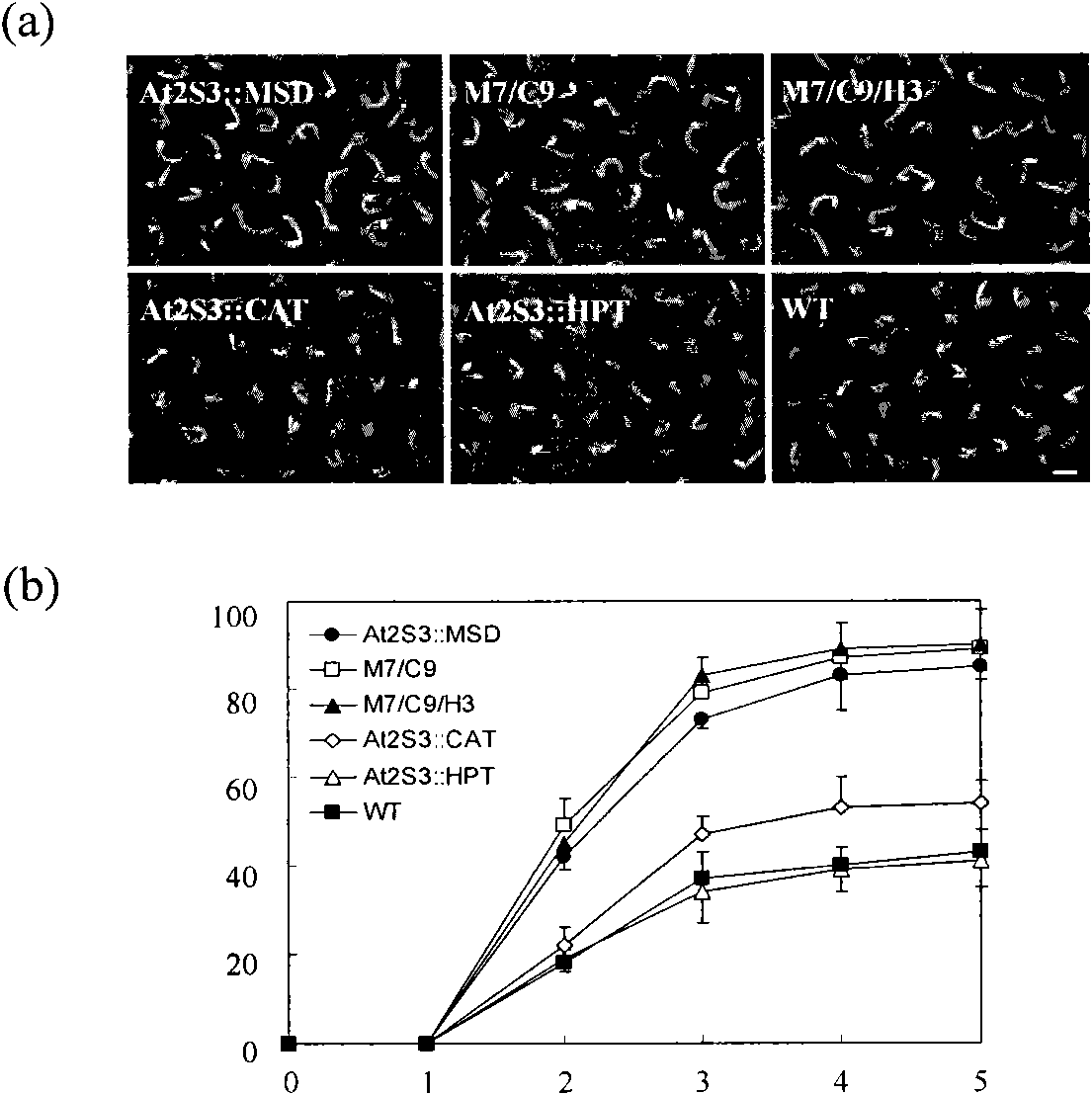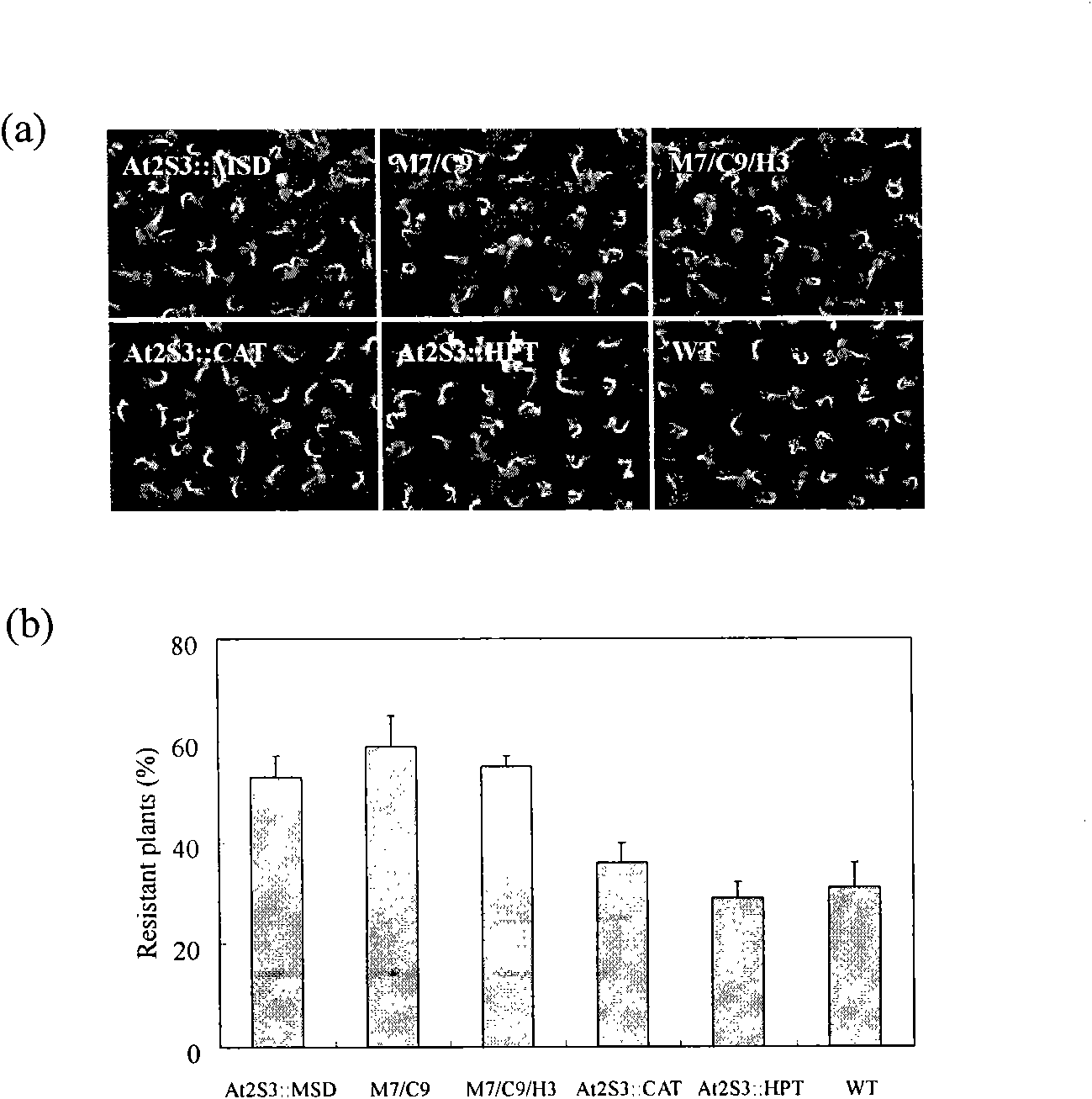Method for improving antioxidant capacity and quality of seeds
An anti-oxidation ability and anti-oxidation technology, applied in the field of molecular biology and biology, can solve the problems of reduced seed viability, agricultural production loss, pest damage, etc., and achieve the effect of improving VE content and anti-oxidative stress ability
- Summary
- Abstract
- Description
- Claims
- Application Information
AI Technical Summary
Problems solved by technology
Method used
Image
Examples
Embodiment 1
[0018] Example 1: Analysis of seed-specific expression of At2S3 promoter
[0019] 1. Extract the genomic DNA of Arabidopsis thaliana leaves, and use specific primers to obtain the full-length sequence of the At2S3 promoter, 1760bp, by PCR cloning.
[0020] 2. The At2S3 promoter was inserted into the upstream of the GUS gene of the expression vector pBI121, and transformed into Agrobacterium GV3101.
[0021] 3. Preparation of Agrobacterium infection solution: Agrobacterium grown to the static growth phase (OD600=0.8), centrifuged at 5000rpm for 5min, the supernatant was kept as a strain, the sediment was suspended with 5% sucrose solution, and 0.3 -0.5‰ Silwet L-77.
[0022] 4. Infection of Arabidopsis thaliana: Immerse the whole Arabidopsis inflorescence in the infecting solution, shake slightly for 6-8 sec, and then take it out quickly; The thaliana was kept in the dark for 12 hours, and then transferred to the long-day condition for growth; the infected Arabidopsis thalian...
Embodiment 2
[0027] Example 2: Construction of At2S3 promoter-driven antioxidant gene expression vector
[0028] 1. Extract total RNA from Arabidopsis thaliana leaves, reverse transcribe into cDNA, and obtain MSD1 (700bp), CAT1 (1504bp) and HPT1 (1197bp) fragments by PCR amplification with specific primers.
[0029] 2. The obtained fragments were respectively inserted downstream of the At2S3 promoter to construct expression vectors.
[0030] 3. The constructed expression vector was transformed into Agrobacterium GV3101.
Embodiment 3
[0031] Example 3: Acquisition of transgenic Arabidopsis and analysis of its ability to resist oxidative stress
[0032] 1. Agrobacteria containing different vectors were used to infect wild-type Arabidopsis inflorescences.
[0033] 2. The harvested Arabidopsis seeds transfected with different vectors were screened separately.
[0034] 3. The obtained transgenic plant seeds are continuously screened on the medium containing kanamycin until homozygous ones are obtained.
[0035] 4. RT-PCR and enzyme activity assay were used to analyze the expression of antioxidant genes at the transcription level and enzyme activity level, and then select the two At2S3:: MSD1(M7) and At2S3::CAT1(C9) were cross-pollinated to obtain a bivalent transgenic line M7 / C9.
[0036] 5. Measure the VE content in the seeds of each strain transformed with At2S3::HPT1 by high performance liquid chromatography, select a strain H3 with the highest content, and cross it with the bivalent transgenic strain M7 / C...
PUM
 Login to View More
Login to View More Abstract
Description
Claims
Application Information
 Login to View More
Login to View More - R&D
- Intellectual Property
- Life Sciences
- Materials
- Tech Scout
- Unparalleled Data Quality
- Higher Quality Content
- 60% Fewer Hallucinations
Browse by: Latest US Patents, China's latest patents, Technical Efficacy Thesaurus, Application Domain, Technology Topic, Popular Technical Reports.
© 2025 PatSnap. All rights reserved.Legal|Privacy policy|Modern Slavery Act Transparency Statement|Sitemap|About US| Contact US: help@patsnap.com



